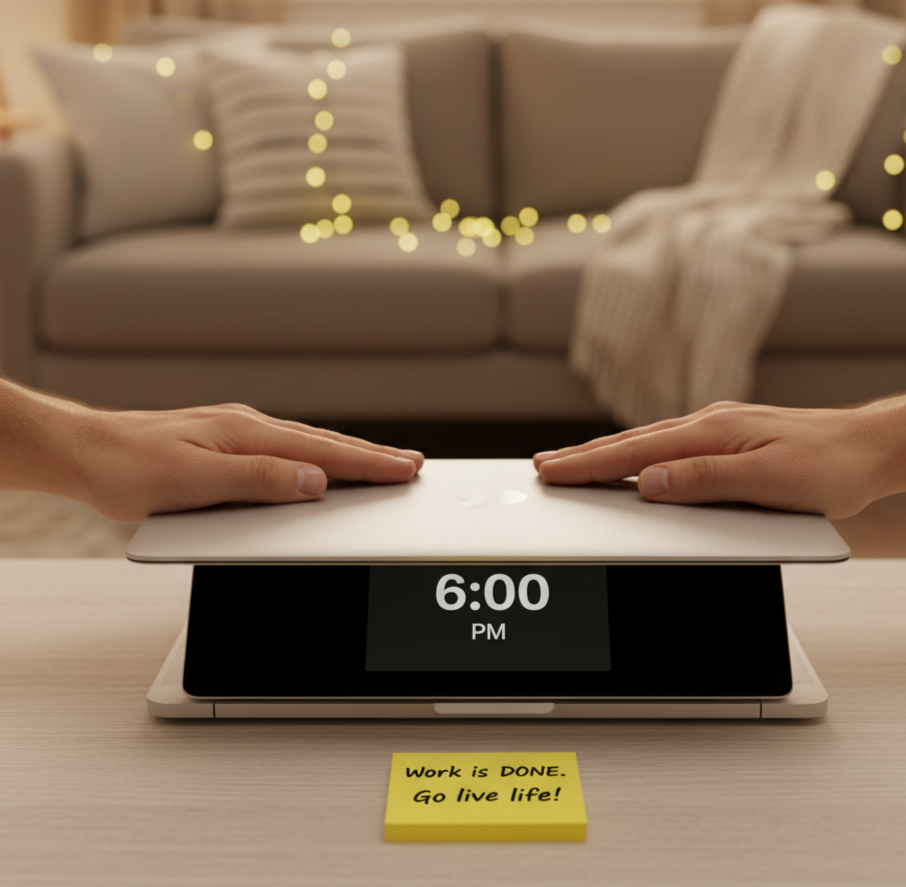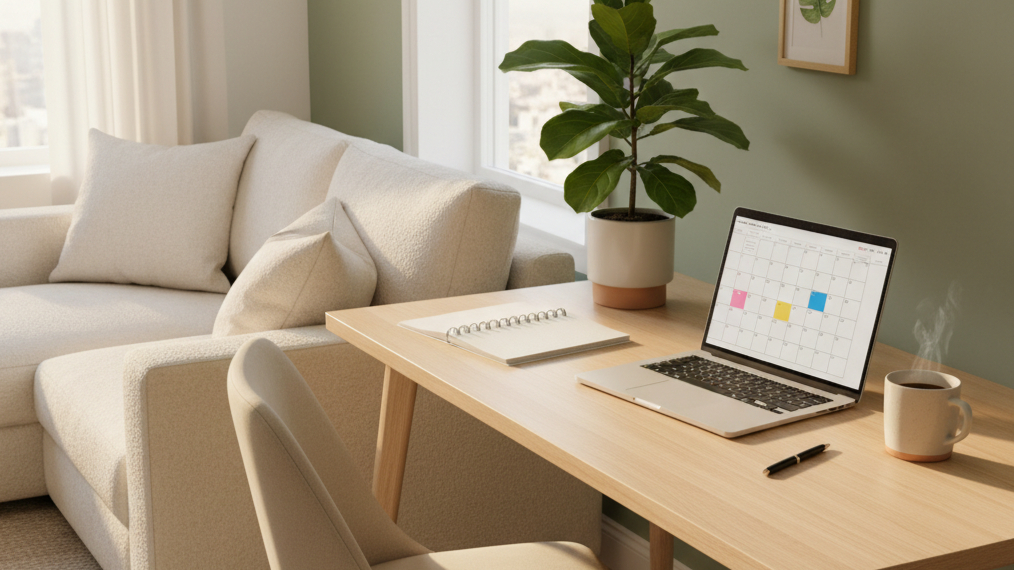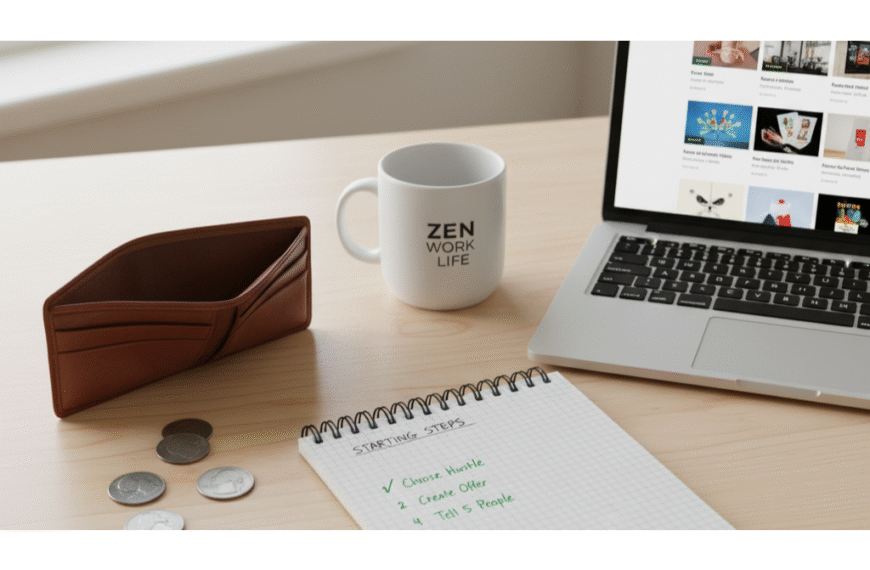Remember the remote work dream?
We all had it. Sipping coffee on the patio, finishing work by 3 PM, maybe hitting the gym or starting a side hustle with all that “extra time.”
The reality, for many of us, looks a little different. It’s 10 PM on a Tuesday, your laptop’s glare is the only light in the room, and you’re just answering “one last email.” Your commute is gone, but your workday… well, it never seems to end.
I’ve been there. For the first year I worked from home, my “office” was my sofa, and my “work hours” were “all of them.” I was more stressed, less productive, and definitely not living the dream.
The truth is, work-life balance doesn’t happen automatically when you go remote. If anything, you have to fight for it harder.
That’s why I’m writing this. Welcome to Work-Life Balance: The Complete Guide for Remote Workers. This isn’t about generic tips like “buy a plant” (though plants are nice). This is a practical, step-by-step guide to help you reclaim your time, set boundaries that stick, and build a remote life that actually feels like freedom.
Let’s dig in.
The ‘Always On’ Trap: Why Work-Life Balance for Remote Workers Feels Impossible
Here’s the core problem: when your home is your office, the physical boundaries that used to manage your life are gone.
There’s no 5 PM commute to signal your brain to switch off. The kitchen isn’t just the breakroom; it’s the 10-steps-away distraction zone. And your laptop? It’s right there on the dining table, mocking you during dinner.
This creates an “always on” culture. I know how frustrating it is. You feel like you could be working, so you feel like you should be working.
This isn’t just a feeling; it’s a documented problem. According to Buffer’s 2023 State of Remote Work report, “not being able to unplug” is the single biggest struggle for 25% of remote workers. We’re working longer, not smarter, and it’s a fast track to burnout.
But here’s the thing: The problem isn’t remote work itself. The problem is that we’re trying to apply old “office-based” rules to a brand-new way of living. We need to redefine what “balance” even means.
It’s Not About 50/50: Redefining “Balance” in a Remote World
When I first started, I had this fantasy of “perfect balance.” I thought it meant eight hours of hyper-focused work, eight hours of fulfilling personal life, and eight hours of perfect sleep.
Let me be honest: that’s a myth. It doesn’t exist.
True work-life balance isn’t a perfect 50/50 split. It’s not a scale that’s always even.
Remote work-life balance is about integration and control.
It’s about being 100% present in whatever you’re doing. When you’re working, you’re working. When you’re with your family, you’re with your family—not half-there while scrolling through Slack on your phone.
It’s about creating a flexible, intentional schedule that serves you, not the other way around. For some, that might be a traditional 9-to-5. For others, it might be working in focused sprints, like 7-10 AM, taking a long afternoon break to go for a run or pick up kids, and then logging back on from 4-6 PM.
The goal isn’t a “balanced” day, but a “balanced” life, where you have control over your time and energy.
Strategy 1: Create Physical and Digital ‘Boundaries’ (That Actually Stick)
This was my biggest “a-ha” moment. You have to re-create the boundaries the office used to provide for you.
When I first went remote, I worked from my sofa. It seemed cozy. The reality? My back hurt, I was constantly distracted by the TV, and worse, my brain started to associate my “relaxation” space with “work stress.”
Here’s how to fix it:
- Have a Dedicated Space. This is non-negotiable, even if you live in a tiny apartment. It doesn’t have to be a separate room. It can be a specific corner of your bedroom, a small desk in the living room, or even the kitchen table. The rule is: work only happens here.
- Use a “Work” Computer (or Profile). If you can, have a laptop just for work. If you can’t, create a separate user profile on your computer. Your “Work” profile has your work apps, a boring background, and bookmarks. Your “Personal” profile has your games, social media, and photos.
- Fake Your Commute. This sounds silly, but it works. Before you “start” your day, go for a 10-minute walk around the block. When you “end” your day, do it again. This simple act creates a mental buffer between “home you” and “work you.”
💡 Pro Tip: At the end of your workday, put your work equipment away. Put your laptop, notebooks, and pens into a bag and zip it up. Slide it under your desk or put it in a closet. Out of sight, out of mind. This physical act is incredibly powerful for telling your brain that work is over.
Strategy 2: Master Your Schedule with ‘Time Blocking’ and ‘Focus Rituals’
In an office, your day has a natural rhythm: people show up, meetings happen, people leave for lunch. At home, your day is a giant, empty, terrifying void of unstructured time.
You have to be the boss of your own schedule. If you don’t, I promise, email and “quick questions” will fill every second of it.
- Time Block Everything. Open your calendar right now. Block out time not just for meetings, but for your work. I block out “Deep Work” (no email, no phone) for my most important tasks.
- Block Personal Time, Too. This is the critical part. Schedule your lunch. Schedule your workouts. Schedule “End of Day Shutdown.” If it’s in the calendar, you’ll treat it as seriously as a meeting.
- Have a ‘Start-Up’ Ritual. Don’t just stumble to your desk and open your email. That’s a recipe for a reactive, stressful day. My ritual: I grab my coffee, sit down, and spend the first 10 minutes reviewing my one or two “Must-Do” tasks for the day. Then I open my email.
This “deep work” concept is crucial. Research from [the University of California, Irvine] found that it can take over 23 minutes to refocus after a single interruption. By time blocking, you’re protecting your most valuable asset: your attention.

Strategy 3: The ‘Off’ Switch: How to Mentally Clock Out When You’re Already Home
This is the hardest part. You can close your laptop, but how do you close the 20 tabs still open in your brain?
For the longest time, I’d “finish” work at 5:30 PM, go make dinner, and then… I’d check my email on my phone. “Just in case.” I was physically logged off but mentally still on the clock. This is especially true if you’re trying to build financial freedom by running [side hustles] after your main job.
The solution is a “Shutdown Ritual.” It’s just as important as your start-up ritual.
Here’s my 10-minute shutdown ritual:
- Check Email/Slack One Last Time: Respond to anything urgent (most things aren’t).
- Review Tomorrow’s To-Do List: Look at my calendar and task list for tomorrow. I write down the 1-2 most important things I need to do. This “dumps” it from my brain so I’m not stressing about it all night.
- Log Out of Everything: I don’t just close Slack, Outlook, and my project tools. I log out. This adds a tiny bit of friction that prevents me from “just checking” later.
- Say “Work is Done.” This felt so silly at first, but now I do it every day. I close my laptop, and I literally say, “Work is done,” out loud. It’s a clear signal to my brain.
That’s it. The whole thing takes 10 minutes, but it’s the difference between “finishing work” and truly being free for the rest of the night.
The ‘Productivity Guilt’ Problem: Common Mistakes I’ve Made
I’ve made so many mistakes on this journey, and most of them come down to one thing: guilt.
Here’s what to watch out for:
- The “Productivity Guilt” Trap: This is the feeling that if you aren’t actively typing, you’re “slacking.” So you don’t take real breaks. You just scroll through social media at your desk. Let me be honest: this guilt is often tied to our [financial goals], and the pressure to always be “on” to earn more.
- Eating Lunch at Your Desk: I made this mistake for a solid year. It’s not a break if you’re still in the “office.” You’re just… eating at work. Go to another room. Sit outside. Do anything but stare at the screen you’ve been staring at all morning.
- Mistaking “Flexibility” for “Availability”: “I’m flexible” should mean you get to flex your schedule. It should not mean you’re available for a 7 PM call on a Wednesday.
⚠️ Watch Out: Don’t fall into the “performance productivity” trap. You are not a machine. Your value as an employee or freelancer isn’t measured in 8-hour increments of non-stop typing. Rest is productive. A clear mind is productive. A happy, balanced life is extremely productive.
This is a mindset shift, and it’s the hardest part. It won’t work for everyone, especially if you’re in a high-pressure role with an inflexible boss. But you have to be the one to start advocating for your own time. No one else will.

Getting Started: Your Simple Plan for Better Remote Work-Life Balance
I know we’ve covered a lot. It can feel overwhelming. So let’s make it simple.
You don’t have to do all of this at once. If you do one thing this week, make it this: Define and defend your workday.
Here’s your 4-step action plan for today:
- Decide on a firm start and end time. Be realistic. Write it down.
- Put it in your calendar. Block it out as “Work Hours.”
- Communicate it. Set your Slack status to “Available 9 AM – 5:30 PM.” Add it to your email signature. As [Harvard Business Review] explains, clearly communicating your availability is key to managing expectations.
- Set an alarm. Set an alarm on your phone for 15 minutes before your new end time. When it goes off, that’s your cue to start your Shutdown Ritual.
That’s it. Start there. It’s the first and most important step to taking back control.
Your Life Is More Than Your Laptop
True work-life balance, especially in 2025, isn’t a final destination. It’s not a box you check.
It’s a daily practice.
It’s a constant, conscious effort to set boundaries, protect your energy, and remember why you wanted the remote work life in the first place. You didn’t choose this life to be more stressed, more connected, and more burnt out than you were in an office.
You chose it for freedom. You chose it for flexibility. You chose it to build a life, not just a career.
It took me a long time to learn this, and I still have days where I fail. I still catch myself checking email at 8 PM. But every small boundary you set—every lunch break you take, every evening you truly unplug—is a win.
You’ve got this.
What’s your biggest challenge with remote work-life balance? And what’s one boundary you’re going to set for yourself this week?
Share in the comments below! I read and respond to every one.
Frequently Asked Questions (FAQ)
Q: This is great, but what if my boss or clients message me after my “end time”? A: This is all about managing expectations. If it’s a true emergency, you can respond. But 99% of the time, it’s not. It’s perfectly acceptable to respond the next business day during your set hours. You train people how to treat you. By consistently not replying after hours, you reinforce your boundaries.
Q: How can I possibly manage work-life balance with kids at home? A: This is a huge challenge, and it requires even more structure, not less. Use time blocking aggressively. Communicate your “focus time” to your family or partner. If possible, create a “shift” system with your partner. Also, be kind to yourself. Some days will be chaotic. The goal isn’t perfection; it’s just trying to carve out time for both.
Q: Is “work-life balance” even a realistic goal in 2025? It feels impossible. A: I totally get this. It feels impossible. I think we need to reframe it from “balance” (which implies a perfect 50/50) to “work-life integration.” It’s about building a life where work fits in, not a life that revolves around work. It is realistic, but it’s not passive. It’s an active, daily choice you have to make.
Q: What’s the best way to avoid remote work burnout? A: Burnout often comes from a lack of control and a feeling of being “always on.” The best prevention is everything in this guide: set firm boundaries, take real breaks (not just at your desk), schedule “off” time, and have a shutdown ritual. Also, have hobbies and social connections outside of work. You need a part of your identity that isn’t tied to your job.



